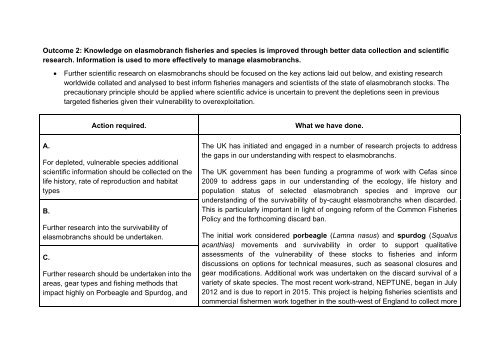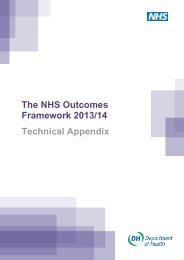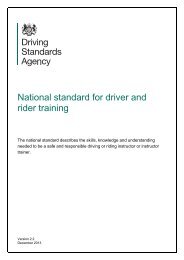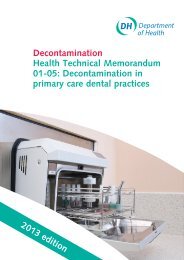A progress review of the Defra shark, skate, and ray ... - Gov.uk
A progress review of the Defra shark, skate, and ray ... - Gov.uk
A progress review of the Defra shark, skate, and ray ... - Gov.uk
You also want an ePaper? Increase the reach of your titles
YUMPU automatically turns print PDFs into web optimized ePapers that Google loves.
Outcome 2: Knowledge on elasmobranch fisheries <strong>and</strong> species is improved through better data collection <strong>and</strong> scientificresearch. Information is used to more effectively to manage elasmobranchs.• Fur<strong>the</strong>r scientific research on elasmobranchs should be focused on <strong>the</strong> key actions laid out below, <strong>and</strong> existing researchworldwide collated <strong>and</strong> analysed to best inform fisheries managers <strong>and</strong> scientists <strong>of</strong> <strong>the</strong> state <strong>of</strong> elasmobranch stocks. Theprecautionary principle should be applied where scientific advice is uncertain to prevent <strong>the</strong> depletions seen in previoustargeted fisheries given <strong>the</strong>ir vulnerability to overexploitation.A.Action required.For depleted, vulnerable species additionalscientific information should be collected on <strong>the</strong>life history, rate <strong>of</strong> reproduction <strong>and</strong> habitattypesB.Fur<strong>the</strong>r research into <strong>the</strong> survivability <strong>of</strong>elasmobranchs should be undertaken.C.Fur<strong>the</strong>r research should be undertaken into <strong>the</strong>areas, gear types <strong>and</strong> fishing methods thatimpact highly on Porbeagle <strong>and</strong> Spurdog, <strong>and</strong>What we have done.The UK has initiated <strong>and</strong> engaged in a number <strong>of</strong> research projects to address<strong>the</strong> gaps in our underst<strong>and</strong>ing with respect to elasmobranchs.The UK government has been funding a programme <strong>of</strong> work with Cefas since2009 to address gaps in our underst<strong>and</strong>ing <strong>of</strong> <strong>the</strong> ecology, life history <strong>and</strong>population status <strong>of</strong> selected elasmobranch species <strong>and</strong> improve ourunderst<strong>and</strong>ing <strong>of</strong> <strong>the</strong> survivability <strong>of</strong> by-caught elasmobranchs when discarded.This is particularly important in light <strong>of</strong> ongoing reform <strong>of</strong> <strong>the</strong> Common FisheriesPolicy <strong>and</strong> <strong>the</strong> forthcoming discard ban.The initial work considered porbeagle (Lamna nasus) <strong>and</strong> spurdog (Squalusacanthias) movements <strong>and</strong> survivability in order to support qualitativeassessments <strong>of</strong> <strong>the</strong> vulnerability <strong>of</strong> <strong>the</strong>se stocks to fisheries <strong>and</strong> informdiscussions on options for technical measures, such as seasonal closures <strong>and</strong>gear modifications. Additional work was undertaken on <strong>the</strong> discard survival <strong>of</strong> avariety <strong>of</strong> <strong>skate</strong> species. The most recent work-str<strong>and</strong>, NEPTUNE, began in July2012 <strong>and</strong> is due to report in 2015. This project is helping fisheries scientists <strong>and</strong>commercial fishermen work toge<strong>the</strong>r in <strong>the</strong> south-west <strong>of</strong> Engl<strong>and</strong> to collect more
















